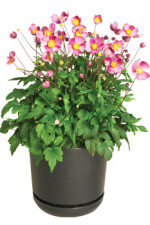Pretty Lady Anemone from Green Leaf Is A Perennial Winner

If you’re looking for a new way to rev up late-season sales, think fall blooming perennials such as the Pretty Lady series of anemones. Pretty Lady not only brightens up the autumn garden, but also combines wonderfully with other fall-flowering staples.
Short & Sweet
The Anemone hupehensis Pretty Lady series is especially notable for its excellent dwarf habit and its floriferous nature, offering a huge improvement in garden and container performance over older, taller varieties. Selected for their outstanding garden worthiness by Blooms of Bressingham and offered by Green Leaf Plants, the Pretty Lady varieties Diana, Emily and Susan are standouts. Among their features are:
– Amazing flower power with showy masses of large 2-inch flowers.
– A naturally compact habit–just 16 inches tall in the garden.
– No vernalization is required for flowering.
– A spread of 20 inches in the garden.
– Hardiness to USDA Zone 5.
Versatile Performers
Anemones are long-lived garden perennials that are also ideal container candidates. They’re terrific for mixing with garden mums, including the hardy Igloo dendranthema series, and other late-blooming perennials such as asters or helianthus. Their contrasting flower form, interesting texture and color add a sparkling accent to fall combination pots.
Trialed For Success
The new products team at Green Leaf Plants put these Pretty Ladies through their paces and found them to be highly reliable performers. They have been trialed in the ground and in pots alongside long-time commercially available anemone varieties. Meticulous technical growing data was collected and compiled to get an accurate read on the plants’ attributes.
The Pretty Lady series starter plants from Green Leaf Plants are produced from root cuttings taken from annually renewed stock. The stock itself is produced from virus- and nematode-negative tissue culture to provide top-quality plants.
Easy To Grow
Transplant liners into 6-inch, 8-inch or 1-gallon pots with one cell per pot using porous soil with good drainage. It’s important to keep the plants moist and not allow them to wilt. Fertilize with 100 to 150 ppm nitrogen constant liquid feed for best results. No pinching or maintenance is required. Grow outdoors in full sun on drip irrigation for best results. Color fades in greenhouse production or if grown under shade.
If unvernalized liners are planted in late May or early June, you’ll have flowering plants in late September to October. For complete variety information and technical guides, visit GLPlants.com.









